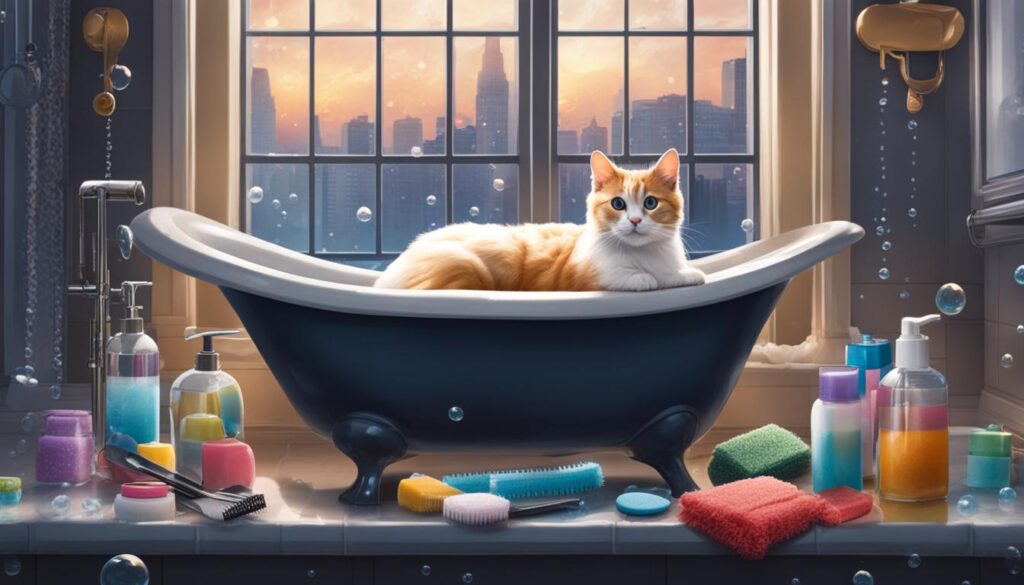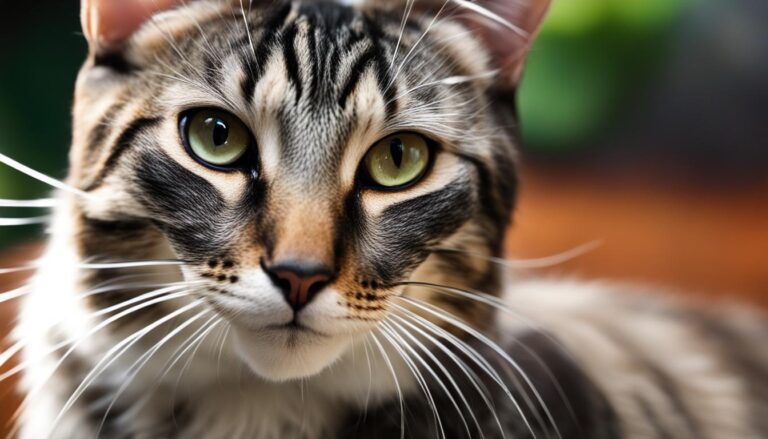Katten en water - het is een combinatie die vaak tot chaos en hilarische YouTube-video's leidt. Maar hebt u zich ooit afgevraagd waarom deze sierlijke wezens zo'n afkeer hebben van nat worden? Als u de redenen achter de afkeer van water bij katten begrijpt, kunt u beter voor uw katachtige vriend zorgen. Laten we eens duiken in de fascinerende wereld van kattengedrag met water en verken de mysteries van katachtige watervrees.
Belangrijkste opmerkingen:
- Ondanks hun domesticatie hebben katten nog steeds evolutionaire instincten die bijdragen aan hun afkeer van water.
- De afkeer van water bij katten wordt ook beïnvloed door ongemak veroorzaakt door een natte vacht en gevoeligheid voor temperatuurschommelingen.
- Individuele ervaringen en genetica spelen een rol in het gedrag van katten met water, waardoor hun reacties variëren.
- Het verzorgen van katten met een wateraversie vereist geduld en een geleidelijke introductie tot water, of het gebruik van alternatieve methoden zoals shampoos zonder water.
- Als u begrijpt waarom katten water haten, kunt u katteneigenaren helpen om het verzorgen en baden minder stressvol te maken, zowel voor henzelf als voor hun katachtige gezelschap.
De redenen achter watervrees bij katten
Katten hebben een goed gedocumenteerde afkeer van water, maar wat is de reden achter dit gedrag? Om te begrijpen waarom katten water haten, is het essentieel om in hun evolutionaire geschiedenis te duiken. Tamme katten stammen af van wilde katten die in dorre gebieden leefden waar waterbronnen schaars waren. In tegenstelling tot hun hondachtige tegenhangers, hoefden katten niet te zwemmen of nat te worden om te overleven. Dit gebrek aan noodzaak heeft geleid tot een instinctieve angst en vermijding van water bij katten.
Bovendien dragen de verzorgingsgewoonten van katten en hun gevoeligheid voor temperatuurschommelingen bij aan hun afkeer van water. Katten zijn nauwgezette zelfverzorgers en gebruiken hun tong om hun vacht grondig schoon te maken. Water verstoort hun natuurlijke verzorgingsroutine en kan ongemak en stress veroorzaken. Daarnaast zijn katten gevoelig voor temperatuurschommelingen en als ze nat zijn, kunnen ze het koud en ongemakkelijk krijgen.
Over het algemeen kan de afkeer van katten voor water worden toegeschreven aan hun evolutionaire instincten, ongemak door een natte vacht en gevoeligheid voor temperatuurschommelingen. Als u deze redenen begrijpt, kunnen huisdiereigenaren beter voor hun katachtige vrienden zorgen en de verzorging en het baden met empathie en geduld benaderen.
Wateraversie overwinnen: Zachte technieken en desensibilisatie
Als uw kat bang is voor water, is het belangrijk om de verzorgings- of badsessies voorzichtig aan te pakken. Laat uw kat geleidelijk aan kennismaken met water door gebruik te maken van ondiepe bakjes of kuipjes gevuld met lauw water. Laat uw kat eerst op eigen houtje het water verkennen en ermee omgaan, en beloon hem met lekkers en lof voor positieve associaties. Na verloop van tijd kunt u de tijd en de intensiteit van het contact met water langzaam opvoeren, waarbij u altijd het comfort van uw kat in de gaten houdt en hem of haar geruststelt.
"Het belangrijkste is om op het tempo van uw kat af te gaan en hem nooit in situaties te dwingen die angst veroorzaken. Geduld, positieve versterking en geleidelijke blootstelling zijn de belangrijkste elementen om de angst van een kat voor water te overwinnen."
Alternatieve verzorgingsoplossingen
Als de afkeer van uw kat voor water aanhoudt ondanks zachte desensibilisatiepogingen, zijn er alternatieve verzorgingsoplossingen beschikbaar. Waterloze shampoos en doekjes kunnen gebruikt worden om uw kat schoon te maken zonder een volledig bad. Deze producten zijn speciaal samengesteld om vuil en geurtjes te verwijderen, terwijl ze zacht zijn voor de huid en vacht van uw kat. Daarnaast kan regelmatig borstelen helpen om de vacht schoon en gezond te houden, zodat u minder vaak in bad hoeft.
Door de impact van negatieve ervaringen te begrijpen, individuele variaties in overweging te nemen en zachte technieken toe te passen, kunnen katteneigenaren de watervrees van hun katachtigen effectiever aanpakken. Elke kat is uniek en het vinden van de juiste aanpak kan geduld en experimenteren vereisen. Uiteindelijk is het doel om een verzorgingsroutine te creëren die stress minimaliseert en uw kat gelukkig en gezond houdt.
Strategieën voor het verzorgen van katten met wateraversie
Het trimmen van een kat met een afkeer van water kan een uitdagende taak zijn, maar met de juiste strategieën kunt u het voor zowel u als uw katachtige vriend een beter beheersbare ervaring maken. Hier volgen enkele tips om u te helpen bij het verzorgingsproces:
- Creëer positieve associaties: Om uw kat te helpen zijn angst voor water te overwinnen, kunt u proberen water te associëren met positieve ervaringen. Bied lekkernijen of knuffels aan in de buurt van waterbronnen om uw kat te helpen een positievere associatie met water te ontwikkelen.
- Introduceer water geleidelijk: Begin met uw kat op een geleidelijke en zachte manier kennis te laten maken met water. Gebruik een ondiepe kom of teil met een kleine hoeveelheid water, en laat uw kat in zijn eigen tempo op ontdekkingstocht gaan. Deze geleidelijke aanpak kan uw kat helpen om zich na verloop van tijd meer op zijn gemak te voelen met water.
- Gebruik waterloze verzorgingsproducten: Als uw kat een sterke afkeer van water heeft, overweeg dan het gebruik van waterloze shampoos of doekjes voor de verzorging. Deze producten kunnen u helpen om uw kat schoon te maken zonder dat u een volledig bad hoeft te nemen, waardoor stress en ongemak voor uw kat worden verminderd.
- Zorg voor comfort en veiligheid: Als u uw kat een bad geeft, is het essentieel om lauw water en zachte producten te gebruiken om ongemak te voorkomen. Zorg er bovendien voor dat uw kat tijdens de verzorging op een veilige en slipvrije ondergrond kan staan.
Onthoud dat geduld en begrip essentieel zijn bij het verzorgen van een kat met wateraversie. Door deze strategieën toe te passen en rekening te houden met de unieke behoeften en voorkeuren van uw kat, kunt u de vachtverzorging voor u beiden draaglijker maken.
Veelgestelde vragen
V: Zijn er specifieke rassen die minder afkerig zijn van water?
A: Hoewel de meeste katten een afkeer van water hebben, hebben sommige specifieke rassen, zoals Maine Coons en Bengalen, laten zien dat ze water beter verdragen en er zelfs van genieten. Er kunnen echter nog steeds individuele variaties voorkomen binnen deze rassen, dus het is essentieel om rekening te houden met de unieke persoonlijkheid en ervaringen van uw kat.
V: Kan ik een haardroger gebruiken om mijn kat af te drogen na het baden?
A: Hoewel sommige katten het gebruik van een haardroger verdragen, is het belangrijk om ervoor te zorgen dat de temperatuur op een zachte en koele stand staat. Vermijd het gebruik van hoge warmte, omdat dit oncomfortabel en mogelijk schadelijk voor de huid van uw kat kan zijn. Het is altijd het beste om uw kat aan de lucht te laten drogen als dat mogelijk is.

Conclusie
Als u begrijpt waarom katten water haten, kunt u hun afkeer veel beter onder controle krijgen en zorgen voor een minder stressvolle vachtverzorging. De afkeer van water bij katten zit diep geworteld in hun evolutionaire geschiedenis, verzorgingsgewoonten, gevoeligheid voor temperatuurveranderingen en verlies van controle in het water. Deze factoren dragen bij aan hun angst voor en vermijding van water, waardoor baden voor veel katteneigenaren een uitdaging wordt.
Hoewel de meeste katten een algemene afkeer van water hebben, zijn er individuele variaties in hun reacties. Sommige specifieke rassen, zoals Maine Coons en Bengalen, kunnen water beter verdragen of er zelfs van genieten. Het is belangrijk om rekening te houden met de unieke persoonlijkheid en ervaringen van elke kat bij het aanpakken van hun afkeer van water.
Om de verzorging van een kat met een wateraversie te vergemakkelijken, zijn er strategieën die gebruikt kunnen worden. Het creëren van positieve associaties met water door traktaties of knuffels in de buurt van waterbronnen te geven, kan katten helpen om zich meer op hun gemak te voelen. Het geleidelijk introduceren van water op een zachte manier met behulp van een ondiepe kom of teil kan ook helpen om katten na verloop van tijd te desensibiliseren. Als alternatief kunnen waterloze shampoos of doekjes worden gebruikt om katten schoon te maken zonder dat ze volledig in bad hoeven, zodat ze zich comfortabel voelen en minder stress hebben.
Door deze zachte technieken toe te passen en rekening te houden met de individuele behoeften van hun katten, kunnen eigenaren beter omgaan met de uitdagingen die wateraversie met zich meebrengt. Dit begrip en deze aandacht kunnen er niet alleen voor zorgen dat het verzorgen en baden voor katten een aangenamere ervaring wordt, maar ook dat de band tussen katteneigenaren en hun katachtige metgezellen wordt versterkt.




